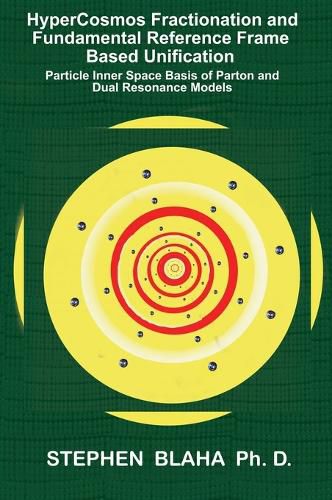Readings Newsletter
Become a Readings Member to make your shopping experience even easier.
Sign in or sign up for free!
You’re not far away from qualifying for FREE standard shipping within Australia
You’ve qualified for FREE standard shipping within Australia
The cart is loading…






We have undertaken an exploration of the Cosmos of almost three years that has led us to the ProtoCosmos and the HyperCosmos. These theories were found by a search for the basis of the Unified SuperStandard Theory (UST) created by this author. The UST was a generalization of The Standard Model. The HyperCosmos defined a spectrum of 10 spaces including a space for our universe.
It also defined an additional spectrum of Limos spaces of very small dimension. These spaces provided a formalism for fractionating particles and symmetries with remarkable consequences. Infinite fractionation (gold dust) gave us a view of fundamental particles, which contained free subparticles, gambols, with classical dynamics, and with no interactions. They are confined within particles.
The gambols may have been found in experiment. Deep Inelastic scattering experiments had been interpreted as evidence of quasi-free partons. The author shows they are gambols. Dual Resonance Models had reduced hadronic interactions including the Veneziano amplitudes to hadrons composed of subparticles in a harmonic oscillator potential. The author shows that these subparticles are gambols (subparticles) in a confining interaction. There is thus strong support for a new substructure of fundamental particles developed by the author using a new fractionation formalism.
Several models of particle substructure are presented leading to the possibility of a new deeper theory of Reality.
The success of the formalism in Deep Inelastic and Hadronic interactions strongly supports both the ProtoCosmos and the HyperCosmos. The relic symmetry group structure found in The Standard Model also supports the HyperCosmos.
The study of the HyperCosmos has also unearthed a new deeper view of Unification the joining of General Relativity and Internal Symmetries. The author introduced Fundamental Reference Frames in recent books. They play a role similar to the rest frame of a particle by reducing the number of components in a space. The author developed a new extended formalism that takes each of the 10 HyperCosmos spaces and generates a larger space that completely unifies General Relativity and Internal Symmetries for each of the 10 spaces. For example, our 4-D universe has a 12-D unification space. Our 6-D Megaverse has a 16-D unification space.
The book also considers relativistic bound state models in detail for the inner spaces of particles, for Charmonium, for high Z atoms, and for atomic nuclear calculations. It suggests a relativistic formulation is essential.
The possibility of starship vacuum propulsion using a new vacuum bubble engine is developed.
$9.00 standard shipping within Australia
FREE standard shipping within Australia for orders over $100.00
Express & International shipping calculated at checkout
We have undertaken an exploration of the Cosmos of almost three years that has led us to the ProtoCosmos and the HyperCosmos. These theories were found by a search for the basis of the Unified SuperStandard Theory (UST) created by this author. The UST was a generalization of The Standard Model. The HyperCosmos defined a spectrum of 10 spaces including a space for our universe.
It also defined an additional spectrum of Limos spaces of very small dimension. These spaces provided a formalism for fractionating particles and symmetries with remarkable consequences. Infinite fractionation (gold dust) gave us a view of fundamental particles, which contained free subparticles, gambols, with classical dynamics, and with no interactions. They are confined within particles.
The gambols may have been found in experiment. Deep Inelastic scattering experiments had been interpreted as evidence of quasi-free partons. The author shows they are gambols. Dual Resonance Models had reduced hadronic interactions including the Veneziano amplitudes to hadrons composed of subparticles in a harmonic oscillator potential. The author shows that these subparticles are gambols (subparticles) in a confining interaction. There is thus strong support for a new substructure of fundamental particles developed by the author using a new fractionation formalism.
Several models of particle substructure are presented leading to the possibility of a new deeper theory of Reality.
The success of the formalism in Deep Inelastic and Hadronic interactions strongly supports both the ProtoCosmos and the HyperCosmos. The relic symmetry group structure found in The Standard Model also supports the HyperCosmos.
The study of the HyperCosmos has also unearthed a new deeper view of Unification the joining of General Relativity and Internal Symmetries. The author introduced Fundamental Reference Frames in recent books. They play a role similar to the rest frame of a particle by reducing the number of components in a space. The author developed a new extended formalism that takes each of the 10 HyperCosmos spaces and generates a larger space that completely unifies General Relativity and Internal Symmetries for each of the 10 spaces. For example, our 4-D universe has a 12-D unification space. Our 6-D Megaverse has a 16-D unification space.
The book also considers relativistic bound state models in detail for the inner spaces of particles, for Charmonium, for high Z atoms, and for atomic nuclear calculations. It suggests a relativistic formulation is essential.
The possibility of starship vacuum propulsion using a new vacuum bubble engine is developed.